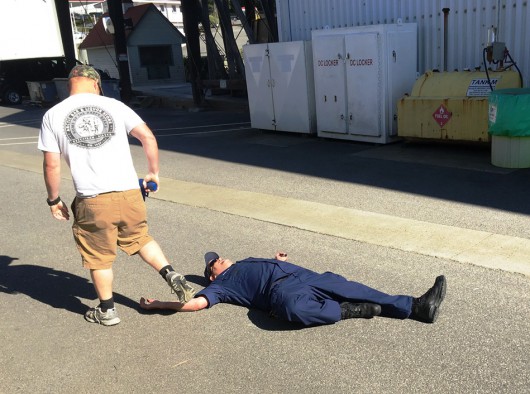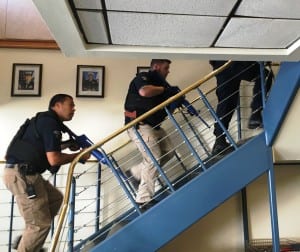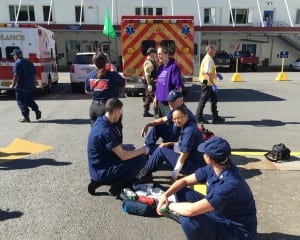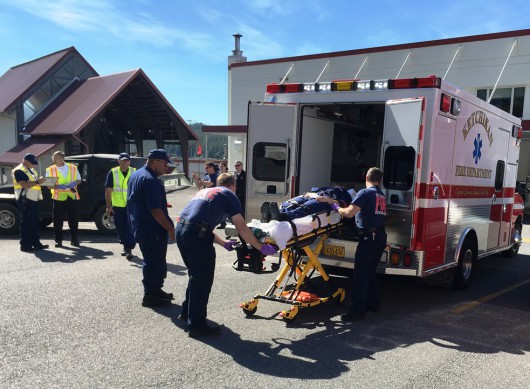
A Coast Guardsman acting the part of an active shooter walks by one of his “victims” during an active shooter drill at the Ketchikan base. (Photo by Leila Kheiry)
The U.S. Coast Guard base in Ketchikan was the scene of a simulated active shooter on Wednesday, complete with fake casualties, a successful “arrest,” and lessons on rapid-response medical care.
Practice makes perfect, right? But how do you practice an emergency? By their nature, emergencies are unpredictable, especially when they involve a vengeful person with a gun.
There are ways to prepare for the unpredictable, though, and that’s what U.S. Coast Guard, Ketchikan police and EMTs worked on during the local Coast Guard base’s first active shooter drill.

Ketchikan Police Department officers head upstairs to capture the bad guy during an active shooter drill at the local Coast Guard base. (Photo by Leila Kheiry)
Waiting for the drill to begin, Coast Guard Public Affairs Officer Lt. Laura Ladd explains the scenario:
“We have a disgruntled fisherman, who his boat got terminated for safety reasons,” she said. “The Coast Guard terminated him. He wants to come on base and get revenge because now we have destroyed his livelihood.”
Ladd said this first drill is meant to help different emergency response agencies learn how to work together. This one is a “walking” emergency drill – slow, deliberate and staged; future events will be faster and less predictable.
The “shooter” started his slow walk on the pier, where his character would have arrived on his condemned boat. Followed closely by two observers, he makes his way up a ramp and onto the base, where he is confronted by an officer, asking for identification.
He shoots the officer, who falls rather convincingly to the ground. Then the shooter walks  to the administration building and asks for directions to the chief’s office.
to the administration building and asks for directions to the chief’s office.
He talks briefly with two personnel downstairs and then “shoots” them, too. An airhorn blasts twice, representing the sound of gunshots.
The bad guy then goes upstairs to the main office area. At some point, someone called 911, because the police quickly arrive, and head upstairs to confront and arrest the shooter.
After the shooter is secured, medical response begins. Fire trucks and ambulances arrive

Emergency Medical Technicians practice treating minor wounds during an active shooter drill at the Ketchikan Coast Guard base. (Photo by Leila Kheiry)
with EMTs, who set up a triage. Coast Guard personnel file out of the building, wearing wristbands to designate how badly they’re injured: Green is for light injuries, yellow for moderate, red for serious.
The greens are all treated on site, a yellow who walked out on her own is placed in an ambulance for transport, and the one red is brought out on a stretcher, stabilized by medics and loaded into an ambulance.
A primary goal of the active shooter drill was better inter-agency coordination. Ketchikan Police Department Deputy Chief Josh Dossett and Ketchikan Fire Department Deputy Chief Scott Brainard agreed that goal was accomplished.
“It was good coordination with the dispatch, the police department and the Coast Guard,” Brainard said. “The three of us don’t work on a lot of these drills together, so this was a good opportunity to get together and do some inter-operability training.”
And it’s just the first drill, with more training planned in the future to make sure Ketchikan’s various responders are ready to work together if a real emergency ever arises.







